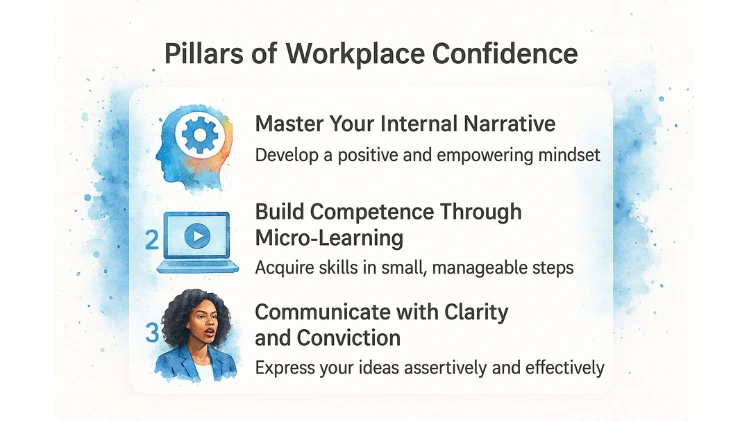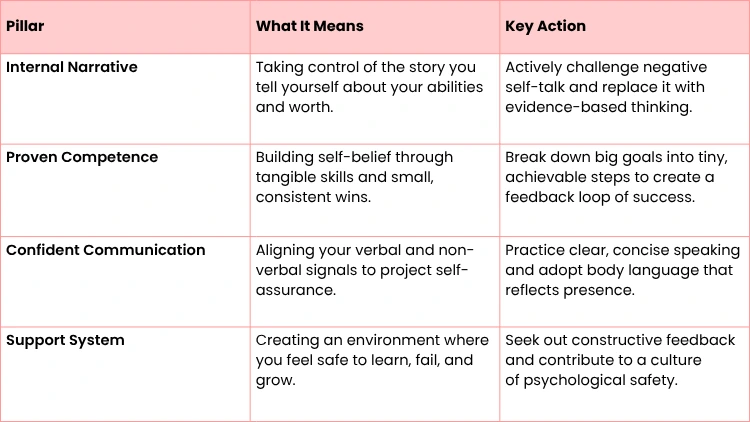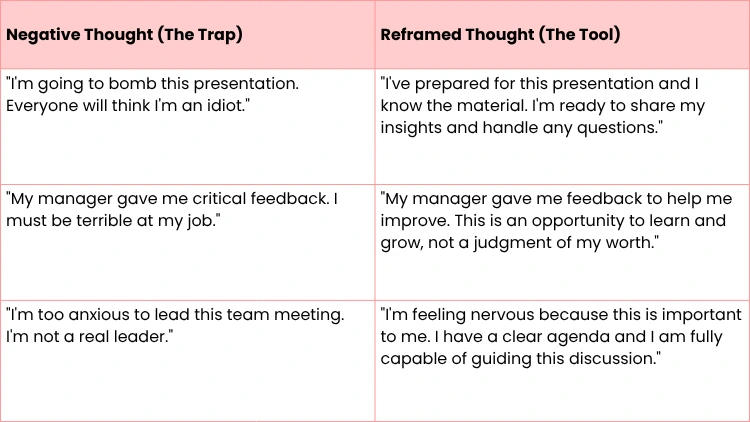How to Build Confidence at Work and Thrive

Building confidence at work isn't about some magical personality transplant. It's an active process, a skill you build piece by piece. It's about combining a healthier mindset with real-world actions. Think of it less like a trait you're born with and more like a muscle you can train through deliberate practice. This guide gives you the framework to do just that.
Jump To Section

Earn As You Learn
Earn 25% commission when your network purchase Uplyrn courses or subscribe to our annual membership. It’s the best thing ever. Next to learning,
of course.
Why Real Workplace Confidence Matters
Let's get one thing straight: true professional confidence isn't about being the loudest person in the room or pretending you have all the answers.
It's the quiet, internal belief in your own ability to handle challenges, contribute something valuable, and learn from your experiences—both good and bad. This is the foundation that lets you volunteer for that ambitious project, speak up with an idea in a meeting, and navigate setbacks without letting them crush you.
When you lack that core self-assurance, every bit of critical feedback can feel like a personal attack. Every new project can trigger a nasty wave of imposter syndrome. This insecurity isn't just an internal battle; it has a measurable impact on your career and, frankly, the company's bottom line.
There's a strong link between employee confidence and engagement, which directly impacts productivity and retention. But get this: a shocking 21% of employees worldwide feel engaged at work, according to a massive study by Gallup. That number points to a huge global disconnect between people's talent and their belief in themselves.
To move beyond just "thinking positive", we need a solid structure. The journey to genuine confidence rests on a few core pillars that all work together. Understanding them gives you a clear roadmap for everything that follows.
This infographic breaks down the core concepts beautifully.
As you can see, confidence is an entire ecosystem, not a single action. It requires you to work on your mindset, your skills, and your communication all at once.

The Four Pillars of Workplace Confidence
To make this simple, we've organized this guide around these four interconnected ideas, which we call the Four Pillars of Workplace Confidence.
Here’s a quick summary of the core concepts we'll use to build lasting professional self-assurance.
Each of these pillars supports the others. For example, building your competence gives you the evidence you need to challenge a negative internal narrative. Communicating more effectively helps you build a stronger support system. It all works together.
By focusing on these areas, you shift from simply wanting to be more confident to actively building the habits and skills that make confidence an inevitable outcome of your professional life.

Master Your Mindset for Lasting Confidence
True, lasting confidence isn't something you can borrow or fake; it’s an inside job. It all starts with the stories you tell yourself every day—that internal narrative that either lifts you up or holds you back. If you want to build real confidence at work, you have to start by mastering your own mindset.
This whole process kicks off by challenging the automatic negative thoughts that so often go unchecked. Your mind might default to self-criticism, especially under pressure, but you have the power to consciously redirect it. The goal isn't to ignore your weaknesses, but to stop your inner critic from drowning out your strengths.
Create an Evidence Journal
One of the most powerful ways to fight feelings of inadequacy is with cold, hard facts. Self-doubt thrives on vague anxieties, but it withers when you confront it with concrete proof of your competence. This is where an Evidence Journal comes in.
This isn't just a diary for your feelings. Think of it as a strategic log of your professional wins, no matter how small they seem.
- Your Task: At the end of each week, jot down three specific accomplishments or positive contributions you made.
- The Goal: To build a tangible, undeniable record of your value that you can pull out whenever self-doubt starts whispering in your ear.
For instance, an entry for the week might look something like this:
- Monday: "Spotted a potential issue in the project timeline and flagged it early. It saved the team from a major delay down the road."
- Wednesday: "A junior colleague was stuck, so I took ten minutes to walk them through the process. They were really grateful."
- Friday: "Got positive feedback from a client about the clarity of my latest report."
These aren't earth-shattering achievements, but they are tangible proof of your daily competence. Over time, this journal becomes a powerful counter-narrative to imposter syndrome.
Reframe and Replace Negative Self-Talk
Your internal monologue has a direct impact on your external performance. When you catch yourself stuck in a negative thought loop, you need a practical way to break the cycle. The "Reframe and Replace" exercise is a simple but incredibly effective tool for this.
The method is straightforward: consciously catch a negative thought and then actively replace it with one that's more balanced and realistic. This isn't about toxic positivity; it's about shifting from a destructive mindset to a constructive one. Understanding the importance of beliefs is key here, as your core beliefs are what shape these automatic thoughts in the first place.
This mental shift is a skill. It gets stronger with practice. The more you consciously reframe your thoughts, the more it will become your default response when you hit a bump in the road.
Key Takeaway: Confidence isn't the absence of self-doubt; it's the refusal to let self-doubt have the final say. By actively collecting evidence and reframing your inner dialogue, you’re building the mental foundation for unshakeable professional self-assurance.
Let's walk through a few common workplace scenarios:

Build Competence to Fuel Your Confidence
Confidence without real-world skill is just bluster. It’s fragile. While your mindset is the engine, your actual competence is the fuel that keeps it running.
Honestly, the most direct and sustainable path to feeling more confident at work is to simply get better at what you do. Every new skill you nail down and each challenge you successfully navigate provides undeniable proof of your value. It’s the kind of cold, hard evidence that finally silences your inner critic.
This creates a powerful feedback loop. The more competent you get, the more confident you feel. That newfound confidence then pushes you to take on bigger challenges, which—you guessed it—builds even more competence. It's a fantastic cycle of self-perpetuating growth.
Unfortunately, many of us feel a huge gap between our current abilities and what we think we need to succeed. And it’s not just a feeling; it’s a global trend. An eye-opening ADP report revealed that only 24% of global workers feel they have the skills needed for the next step in their careers.
This doubt is a massive barrier. When people question their own abilities, they're far less likely to seek out the very opportunities that would build both their skills and their confidence.
So, how do you start closing that gap? It begins with an honest look in the mirror.
Conduct a Personal Skills Audit
Before you can build anything, you need a blueprint. Think of a Personal Skills Audit as a straightforward way to map out where you shine and where you need to put in some work. This isn't about judging yourself—it's about gathering data to create a smart action plan.
Grab a notebook or open a fresh document and create two simple columns: "My Strengths" and "My Growth Areas".
- Under Strengths: Jot down the skills your colleagues always ask for your help with. What parts of your job feel almost effortless? Think about any positive feedback you've received.
- Under Growth Areas: Be real with yourself. What tasks make you want to hide under your desk? What skills keep popping up in job descriptions for the roles you’re eyeing?
This simple exercise brings instant clarity. It shifts you from a vague, anxious feeling of "I need to get better" to a concrete target like, "I need to get more comfortable with public speaking" or "I really should master advanced spreadsheet functions".
Develop a Micro-Learning Habit
Once you have your target, the trick is to avoid overwhelming yourself. The idea of mastering a huge new skill can be paralyzing. The better approach? Break it down into tiny, manageable pieces by creating a Micro-Learning Habit.
This just means setting aside a small, consistent block of time each day for focused learning.
The 15-Minute Rule: Commit to spending just the first 15 minutes of your workday on one specific learning goal. That could be watching a quick tutorial, reading a relevant industry article, or just playing around with a new software feature. It's small enough that you can't make excuses, but consistent enough to build real momentum.
Let's see how this plays out in the real world.
Scenario: A Marketing Associate's Journey
Meet Alex, a marketing associate who feels totally insecure about data analysis. During team meetings, Alex clams up, intimidated by the charts and metrics everyone else discusses so fluently.
Here’s how Alex uses this framework to turn things around:
- Skills Audit: Alex quickly identifies "Data Analysis" as a major growth area.
- Break It Down: Instead of a fuzzy goal like "get better at data", Alex gets specific. The first two micro-skills are "Mastering Pivot Tables" and "Learning Google Data Studio Basics". To truly gain expertise in your areas of interest, you have to break complex topics down into smaller, digestible chunks.
- Micro-Learning: Every morning, Alex uses the 15-minute rule to work through an online course on pivot tables. After a few weeks, that focus shifts to a Google Data Studio tutorial series on YouTube.
- The Result: Two months later, Alex isn't just following the data conversations in meetings—Alex is contributing to them, pulling out key insights from campaign reports with newfound confidence. That tangible skill directly translated into an unshakable feeling of competence.
As you build these new skills, you’ll want a way to track and showcase your progress. A great next step is to build a comprehensive professional portfolio. It’s a powerful visual record of your competence that reinforces your own confidence and proves your value to others.

Communicate with Clarity and Conviction
How you communicate at work does more than just get a point across—it sends a powerful signal about your professional confidence. Ever notice how speaking with hesitation, peppering your sentences with "ums" and "ahs", or avoiding eye contact can make even the most brilliant ideas fall flat? It’s an unconscious thing, but it can seriously undermine your authority.
Confident communication is a skill, and like any skill, it can be learned. It’s all about structuring your thoughts clearly, choosing your words with intention, and letting your body language project composure. When what you say and how you say it are in sync, you come across as a credible, self-assured professional who deserves to be heard.
Speak Up Smoothly in Meetings
We’ve all been there. A fast-moving discussion is happening, you have a great idea, but you can’t find a gap to jump in. Staying silent often leads to that "I should've said something" feeling later. The secret isn't waiting for a perfect, awkward silence that never comes; it's having a few "bridge phrases" in your back pocket.
These phrases help you enter the conversation smoothly and respectfully. Instead of interrupting, you’re connecting to what’s already being said, which shows you’re an active listener. If you're looking for a deeper dive, this guide on how to speak up with confidence in meetings has even more practical tips.
Here are a few scripts you can steal:
- "That's an interesting point, and I'd like to add..."
- "Building on what Sarah just said, have we considered..."
- "I see your point about the timeline. From a resource perspective, I have a thought on that."
Structure Your Thoughts with the PREP Method
Ever been put on the spot for your opinion and found yourself rambling? It happens. Confident speakers, however, often know how to structure their thoughts on the fly. One of the most effective tools for this is the PREP method. It's a simple, four-part framework that keeps your message concise, logical, and persuasive.
Here’s the breakdown:
- Point: Start with your main point or conclusion.
- Reason: Explain why you believe this to be true.
- Example: Offer a specific example or data to back up your reason.
- Point: Circle back and restate your main point to really drive it home.
Scenario: Imagine your manager asks for your take on a new software tool during a team huddle. Instead of a vague, "Um, yeah, I think it's good", you can use PREP: (P) "I believe we should adopt the new software." (R) "My main reason is that it will drastically cut down on our manual data entry time." (E) "For instance, during last week's trial, it automated the reporting process that currently takes me two hours every Friday." (P) "So yes, I definitely think it's a worthwhile investment."
This simple structure makes your contributions sound thoughtful and authoritative. To really bring clarity and conviction to your daily interactions, you need to master communication skills that help you articulate ideas this effectively.
Project Confidence Through Body Language
Your body often communicates more than your words do, especially when you're nervous. Slouching, fidgeting, or looking at the floor can betray your anxiety. The good news is that consciously adopting confident body language can actually make you feel more confident. It’s a classic "fake it 'til you become it" situation that really works.
Focus on these three key areas to start:
- Eye Contact: Aim for steady, comfortable eye contact. It shows you're engaged and sincere. Don't get into a staring contest, but don't study your shoes, either.
- Open Gestures: Avoid crossing your arms, which can make you seem closed off or defensive. Using open-palm gestures when you speak helps you appear more approachable and trustworthy.
- Posture: Stand or sit tall with your shoulders back. Taking up a little space projects presence and self-assurance.
When you pair these non-verbal cues with clear, structured speaking, you create a powerful, cohesive message of professional confidence.

Cultivate Your Professional Support System
Let's be honest: confidence is rarely a solo mission. It's something that grows when you're surrounded by the right people. Building a solid professional network is one of the most powerful things you can do to bolster your confidence at work, creating a buffer against self-doubt and giving you a much-needed dose of perspective.
This isn't just a "nice-to-have". The people and environment around you directly shape how you feel and perform. In fact, the 2025 Gensler Global Workplace Survey found that since the pandemic, human connection has become a top priority. Time spent socializing with coworkers has nearly doubled, which strengthens relationships and builds psychological safety—a critical ingredient for feeling confident.
Go Beyond a Single Mentor
The classic advice is to "find a mentor". While that’s a great start, pinning all your hopes on one person can be risky. What if they get busy or leave the company? A much smarter strategy is to build a personal "board of directors"—a small, curated group of people who support you in different ways.
Think about assembling a team like this:
- A Mentor: A senior person in your field you can turn to for big-picture career advice.
- A Peer Coach: A trusted colleague at your same level who gets the day-to-day grind and can be a sounding board.
- A Sponsor: A leader with influence who will actively champion you and your work, especially in rooms you aren't in.
Starting with a mentor is often the most straightforward first move. If you're not sure how to approach someone, this guide on how to ask someone to be your mentor has practical tips to get you started.
Build Your Peer Advisory Group
Some of the best support you'll ever get comes from the people fighting the same battles alongside you. This is where a Peer Advisory Group comes in. It's just a small, informal circle of trusted colleagues at a similar stage in their careers.
This becomes your safe space—a place to vent about challenges, celebrate the small victories, and brainstorm solutions without any fear of judgment.
Imagine a junior developer is stuck on a tough coding problem. Instead of spinning their wheels alone, they bring it to their peer group. One person might share a link to a helpful resource, while another offers to pair-program for 30 minutes to get them unstuck. It solves the immediate problem, sure, but it also reinforces that it’s completely okay not to have all the answers.
Case Study: A junior developer was feeling overwhelmed before her first major promotion review. She leaned on her personal 'board of directors'. Her mentor helped her frame her accomplishments for senior leadership, her peer coach ran mock review questions with her, and her sponsor had already been highlighting her project successes to key decision-makers. This 360-degree support system gave her the confidence to navigate the promotion process successfully.
Manage Your 'Confidence Drainers'
Just as you build up a positive network, you also have to learn how to protect yourself from those who chip away at your self-belief. We all know them—the "Confidence Drainers". They're the colleagues whose constant negativity, unsolicited criticism, or passive-aggressive comments leave you feeling drained and doubtful.
Setting professional boundaries is a crucial skill, and it doesn't have to be a big confrontation.
Actionable Insight: Let's say a colleague constantly picks apart your work without offering any real help. Instead of getting defensive, try a calm, professional redirect. You could say, "I appreciate you pointing that out. For my own learning, could you share how you would have approached it differently?" This simple question shifts the dynamic from a personal attack to a professional discussion and often disarms the negative behavior on the spot.
Turning Confidence Into a Habit
Building professional confidence isn't a project you finish and shelve; it's a daily practice, like stretching a muscle. The real work is in mastering your internal monologue, proving your skills to yourself with real accomplishments, speaking with conviction, and having people in your corner who lift you up. Now, let's make it real.
The secret to lasting change isn't some massive, heroic effort. That's a recipe for burnout. It’s about taking small, deliberate actions that build on each other. Tiny, consistent steps create a powerful momentum that's hard to stop. This is how you build confidence that actually sticks.
Your 30-Day Confidence Action Plan
To get you started, here’s a simple game plan for the next month. The goal here isn't perfection—it's progress. Just pick one or two of these each week that feel like a slight stretch, but are totally doable.
- Week 1: Ask for Feedback. Find a recent, low-stakes task you completed. Pull a trusted colleague aside and ask for their specific thoughts. Getting comfortable with constructive criticism is a superpower.
- Week 2: Voice One Idea. In your next team meeting, your mission is to contribute one thought. You can even build on someone else's point. A simple "Building on that, have we considered..." is a great way to ease into the conversation.
- Week 3: Log a Win. Before you sign off for the week, jot down one specific thing you accomplished in your Evidence Journal. It doesn't have to be monumental—maybe you solved a nagging problem or helped a teammate who was stuck.
- Week 4: Share What You Know. Offer to give a quick, informal update on a project you're deep in. A simple five-minute share in a team huddle is a fantastic, low-pressure way to practice speaking with authority.
The big takeaway here is that confidence isn't some finish line you cross. It's the sum of the small, brave choices you make every single day. Consistent action, no matter how minor, is what forges that deep, unshakable self-assurance in your career.
Got Questions? We've Got Answers
Building real, lasting confidence isn't an overnight job; it's a process. Along the way, you're bound to run into some common hurdles and tricky questions. Here’s some straightforward advice for the situations we get asked about most.
How Can I Look Confident When I Feel Nervous Inside?
This is the classic "fake it 'til you make it" scenario, and honestly, it works. The key is to focus on your physical presence, because your body can actually trick your brain into feeling more composed.
Start with your posture. Stand tall, pull your shoulders back, and lift your chin. This simple adjustment, sometimes called a power pose, sends a signal to your brain that you're in control. Before a big presentation or a tough conversation, find a private moment to take a few slow, deep breaths. It’s a simple trick, but it physically calms your nervous system down.
Ultimately, though, the best antidote to nervousness is preparation. When you know your material cold, you remove the fear of being caught flat-footed. That knowledge is the bedrock of genuine confidence.
Try This: Before your next big meeting, duck into an empty office or even a bathroom stall. Stand with your hands on your hips and your chest out for just 60 seconds. It feels a little silly, but studies show this can lower your stress hormones and give you a tangible confidence boost.
What's The Difference Between Confidence And Arrogance?
This is a big one. People are often so afraid of appearing arrogant that they downplay their own skills. The difference really comes down to one thing: humility.
Confidence is quiet. It's an internal belief in your skills, backed by actual experience. A confident person isn't afraid to ask questions or admit they don't have the answer. They see value in other people's expertise.
Arrogance, on the other hand, is loud. It’s usually a mask for deep insecurity, which comes out as a need to prove you're the smartest person in the room. Arrogant people dismiss other ideas and never, ever admit they're wrong.
A truly confident person knows their worth but also knows they're part of a team. They lift others up instead of tearing them down.
How Can I Recover My Confidence After Making A Mistake?
We've all been there. The feeling in the pit of your stomach after you've dropped the ball is universal. The way you handle it, however, is what defines your professionalism and rebuilds your confidence.
First, own it. Don't hide, don't blame, don't make excuses. Go to the relevant people, explain what happened, and—this is the most important part—tell them how you're going to fix it. Taking immediate accountability shows integrity and builds trust, even when you've messed up.
Then, you have to shift your mindset. Treat the mistake as a piece of data, not a judgment of your entire career.
- Ask yourself: "What broke down in the process that allowed this to happen, and how can I prevent it next time?"
- For example: If you missed a major deadline, you could approach your manager and say, "I completely misjudged the time needed for this task, and I sincerely apologize. I'm staying late tonight to get it done, and going forward, I'll be blocking out dedicated time in my calendar for this type of project."
Finally, be kind to yourself. One mistake doesn't erase all your past wins. Pull out that "Evidence Journal" we talked about earlier and remind yourself of all the times you got it right. It helps put a single error back into its proper, smaller perspective.
At Uplyrn, we believe skill-building is the most reliable path to genuine professional confidence. Our platform connects you with expert-led courses and mentors to help you master new abilities and prove your competence to the most important person—yourself. Start your learning journey with Uplyrn today.


Leave your thoughts here...
All Comments
Reply